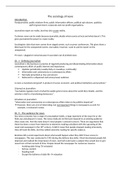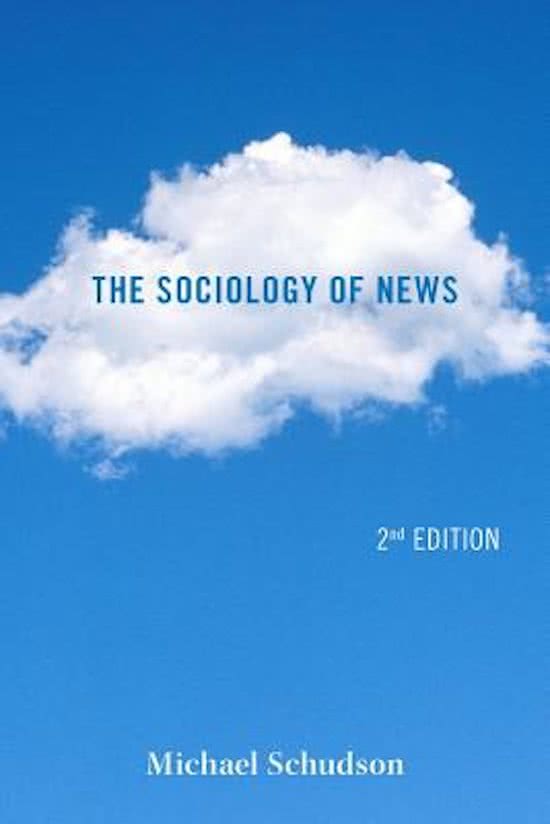The sociology of news
Introduction
Parajournalists: public relations firms, public information officers, political spin doctors, publicity
staff of government, corporate and non-profit organisations.
Journalists report on reality, but they also create reality.
Tuchman: news can be made because journalists decide what counts as facts and what doesn’t. This
gives journalists the power to create reality.
Sociologists claim that news comes from staged events, such as press conferences. This gives them a
blind spot for the unexpected events. Journalists, however, want to and do report on the
unexpected.
TV news = plagiarism news because it was taken out of printed news.
Ch. 1 - Defining journalism
Journalism is the business or practise of regularly producing and disseminating information about
contemporary affairs of public interest and importance.
Updates periodically (usually daily or nowadays, continually)
Information and commentary on contemporary affairs
Normally presented as true and sincere
Delivered to a dispersed and (anonymous) audience
Is news a manufactured good? A product of social, economic, and political institutions and practices?
Gripsrud on journalism:
“Journalists regulate much of what the public gets to know about the world they inhabit, and this
activity is vital to a functioning democracy”.
Schudson on journalism:
“Information and commentary on contemporary affairs taken to be publicly important”.
However, there are a lot of interesting, but not important things in newspapers as well. For
example, a restaurant review.
Ch. 9 – The audience for news
Any news consumer has a range of consumption habits, a large repertoire of the ways he or she
finds use and pleasure in news. The news media do not find and respond to an existing audience;
they create one. And the news doesn’t need people’s constant concern. There are arguments that
there has been a move from intensive to extensive reading coincident with the upcoming of the
novel and newspaper in the 18th century. It didn’t mean that people stopped reading intensively,
they still read the bible, but they added extensive reading for specific subjects.
Berelson did a social experiment about what would happen when they didn’t have access to
newspapers. This was conducted in 1945 during the delivery boy strike. Most interviewed people felt
deprived and realised the importance of news. Just half could name a subject they would love to get
news from at that moment of time. People missed the newspaper for numerous reasons:
- Assisting daily living (TV schedule)
- Serious content
- Reading itself
- Escape the dullness of daily life relaxation
, - Killing time
- Subjects to talk about
- Para-social interaction (reporters felt like family, gossip)
Glasser found out that people weren’t informationally unprepared, but emotionally unprepared. No
serenity. Ritual function.
Something will attract people to newspapers throughout their lives. Say, cartoons sports section
economics section etc. When the editors change the look or style, people are more likely to
actively interact with the newspaper via the editor.
Journalists will be stubborn when it comes to feedback, whatever they like the audience will like.
Plus, they want to impress their colleagues more than they want to reach the audience. Nowadays,
with the news online, people are more likely to show/mail their thoughts on the piece to journalists.
Newspaper readers, TV broadcast listeners, etc. are declining steeply. For youngsters, the internet
has already surpassed newspapers and broadcasts as the main source of information gathering.
Fears for this development are economically based and culturally based. Other voices say that say
that this new media enables news to reach a wider public because it doesn’t have the stuffiness old
newspapers have.
Costera Meijer & Groot Kormelink (2014)
Purcell, et al (2010) three drastic shifts:
- News in fixed places and at fixed times news in mobile places and at flexible times
- Generalized news customized news
- Passively consumed actively contributing
Information to a social experience (Hermida, et al. 2012)
Why the claims were overstated:
- Use of surveys. It is in people’s nature to overestimate.
- Frequency fallacy. Once paying attention, noticing more.
- Duration fallacy. Not just seeing, but the time spend is important.
Objective paper:
1. Answers questions about how practices of news have changed. (Digitalization of news and
introduction social media)
2. Deepen and expand existing professional and academic vocabulary about journalism.
Starting point ≠ people’s opinion but their everyday experiences. This approach doesn’t avoid
people’s opinion but enables them to share their considerations, decisions, behaviour, and
experience. Result: underlying user configurations were detected by applying the interpretive
repertoire.
This paper will discuss 24 practices of news use:
Reading
Reading can be different for a variety of situations. You read novels at ease and academic papers
with great concentration. Back in the day ‘reading’ was most often used in combination with papers.
Nowadays news has been less tied to one specific platform. There has been a shift towards online
platforms.
,Watching
Watching the news was seen as an intensive activity and there weren’t supposed to be any
distractions. Digital news media made it possible for people to watch like they’re reading a
newspaper, pause/play, etc. always. With the upcoming of the iPhone, it has even become easier.
Where the news used to offer structure for an entire household, it now offers structure for one-ish
person within a household. People within a household can watch the news on their own terms.
Besides fulfilling an informational, ritual, and communicative function, watching, like reading, offers
a moment of pleasure.
Viewing
As opposed to ‘watching’, ‘viewing’ is more relaxed and laid back. People are doing something else
at the same time, breakfast prep for example. Often, when content becomes truly interesting, the
consumer will switch to actively viewing mode.
Glancing
This means subconsciously taking a brief or hurried look at the news headlines. Low-intensity news
in combination with another activity. For example, seeing a bus ad while driving at the same time.
Listening
Listening as a form has seldom been mentioned until the end of the 2 nd decade. Listening to news is
associated with creating intimacy. Podcasts can be selected with a specific mood. Listening to a
podcast is more intense than hearing but not as intense as reading or watching because it can, and
often is, combined with another activity. Podcasts are considered more nourishing and useful than
watching YouTube for example.
Hearing
Recent distinction. Hearing the news less in its own right than part of a more general experience. An
example, trying to fall asleep while listening to the news. You hear noise (news) while you focus on
sleep (sound). Content matters but more important are the diversions, entertainment, and
companionship it offers and the feeling of being connected to the outside world.
Checking
News ‘checking’ is a habitual activity to find out if anything ‘new’ and ‘interesting’ has happened.
People seemed to be more interested in being on top of the news rather than understanding the
news. Apps and smartphones have contributed to this trend; it has become more convenient to
‘check’ the news. News has moved from a moment of pause to a time-filling activity. There is now
often a “checking cycle” where people have a list of apps, they check to gain the latest information.
Snacking
The news offers a wide range of subjects and is thus very varied. NU.nl for example, isn’t very in
depth but perfect for a combination with a cup of coffee before work. It’s like flicking through a
magazine. NOS stories, not interested? Ability to scroll down quickly.
Scanning
People stick to the headlines to get a sense of the news. Efficiently scanning the news, often in/for a
specific dimension. People stay on the very surface. Good for making conversation, prevents the
feeling of being left out.
, Monitoring
Actively surveying the informational environment to be able to come into action when necessary.
Not scanning, because this lacks a sense of urgency. Also, monitoring focusses on one subject. For
example, Peter R. de Vries.
Searching
When searching, people want to find an answer to a specific question. Most often, people use the
first hit Google offers them. However, this doesn’t mean that the news consumer doesn’t have a
preference when it comes to news source. Due to ‘smartphonization’ and ‘Wi-Fiction’ people can
combine searching with activities such as having dinner.
Clicking
Hitting news items or likes for more information is a particular news habit called clicking. This term
has two different functions: (1) clicking on hyperlinks within news and (2) clicking on individual news
items. Clicking on hyperlinks gives the consumer on how much extra information they’re getting.
Clicking on individual news articles requires an additional activity. People are more likely to click on a
funny, shocking, etc. headline. Its about entertaining yourself with relatively useless news. Note: it
doesn’t say anything about the interest of that consumer in that field.
Saving
Two purposes for saving: (1) saving for when one has time to read the article and (2) saving for
future reference. Includes scanning or scrolling through the article to see if it is worth saving. In the
end, people often don’t read the saved articles.
Scrolling
Default mode for social media. People feel an urge to keep scrolling and don’t stick around long.
Because the consumer wants a brain break?
Triangulation
Trust and truth are higher on people’s agenda nowadays. Triangulation in the context of news refers
to the use of a variety of sources to verify the truth of a particular news story. There are three forms
of this concept: (1) gathering additional evidence (2) gathering additional details (3) to later use in
arguments. The first two have a connection, social media. They either first read it on social media, or
they stay on social media to stay on top of the news before the mainstream media reports on it.
Avoiding and abstaining
The term ‘avoiding’ is used when people actively skip or move around news due to the topic or
valence. Say, skipping the sports section. Valance-based-avoidance: avoiding subjects to maintain a
person’s frame of mind. The term ‘abstaining’ is used when people deliberately stay away from news
all together or limit their exposure. Often people feel the need to stay away from the news, only a
few people act on this urge.
Note the terms: linking, sharing, liking, recommending, commenting, voting, and tagging. Definitions
are obvious. What keeps people from acting on social media, with the options above, isn’t the
difficulty, it’s the expected response from others.
Cluster 1: reading, watching, listening
truly emerging oneself into the subject
Cluster 2: glancing, snacking, scrolling
impression without engaging. Diversion from seriousness.





